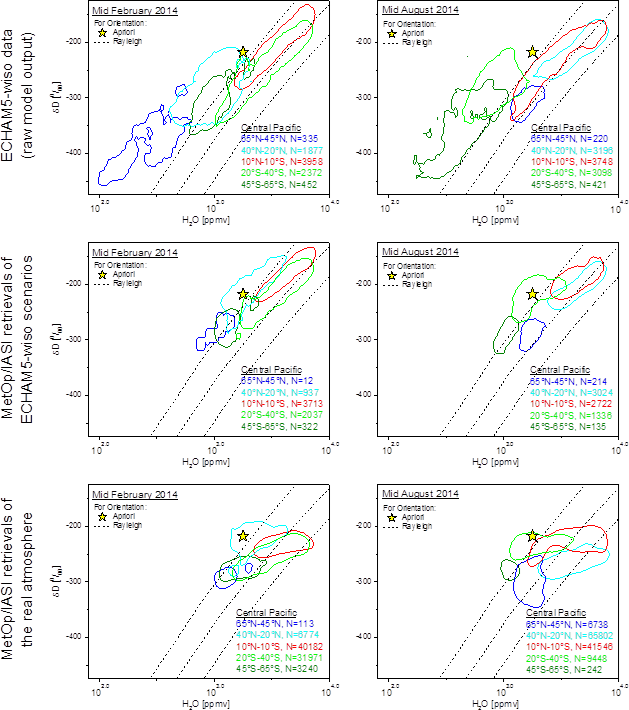Multi-platform remote sensing of water isotopologues
We optimise and perform remote sensing retrievals using ground-based high resolution FTIR (Fourier Transform InfraRed) spectrometers and the IASI (Infrared Atmospheric Sounding Interferometer) instruments aboard the satellites MetOp, and we document in great detail the representativeness and the uncertainty of these remote sensing data products. Our focus is the generation and characterisation of tropospheric water vapour isotopologue remote sensing data and their application for tropospheric moisture transport pathway studies. More details on our research fields are given here.
The importance of remote sensing data characterisation
A comprehensive understanding of the remote sensing data characteristics (representativeness and uncertainty) is of fundamental importance in particular, if we work with data that have a complex nature, like the ratios of the H216O and HD16O isotopologues (typically expressed as δD = {[HD16O]/[H216O]}/VSMOW – 1; where VSMOW means Vienna Standard Mean Ocean Water).
The attached Figure illustrates an example of {H2O,δD} pair distributions, which are useful proxies for investigating different moisture transport pathways. The top panels show model data (raw model data output), the middle panels show model data that have the characteristics of the MUSICA MetOp/IASI remote sensing data assimilated and the bottom panels show MUSICA MetOp/IASI remote sensing data. Comparing the raw model data with the remote sensing data (i.e. comparing the top panels with the bottom panels) reveals very large differences. However, this is a comparison of data with very different characteristics and the observed differences are not meaningful. A comparison between model and remote sensing data is only meaningful if we understand the remote sensing data characteristics and assimilate it to the model data. In this context we have to compare the middle and the bottom panels and the observed differences allow meaningful conclusions and can contribute to further model improvements.

Example of using satellite-based remote sensing {H2O,δD} pair distributions for evaluating the moisture transport in an atmospheric model: The contour lines represent areas with highest {H2O,δD} pair data densities for different latitudinal belts and seasons in the free troposphere over the central Pacific (140°E-140°W) as seen by ECHAM5-wiso model simulations and in the MetOp/IASI retrieval data. From the top to the bottom: distributions obtained from ECHAM5-wiso simulations, from ECHAM5-wiso simulations after passing through the retrieval simulator and from the MetOp/IASI retrievals, respectively. Left panels for mid-February and right panels for mid-August. The different colours represent the different latitudinal belts as given in the legend. The black dashed lines represent Rayleigh curves for three different initialisations: {T = 10°C; RH = 60%; δD = -89‰}, {T = 20°C; RH = 80%; δD = -78‰} and {T = 30°C; RH = 100%; δD = -69‰}. The yellow star marks the a priori value used for the remote sensing retrievals. More details are given in Schneider et al. (2017).
